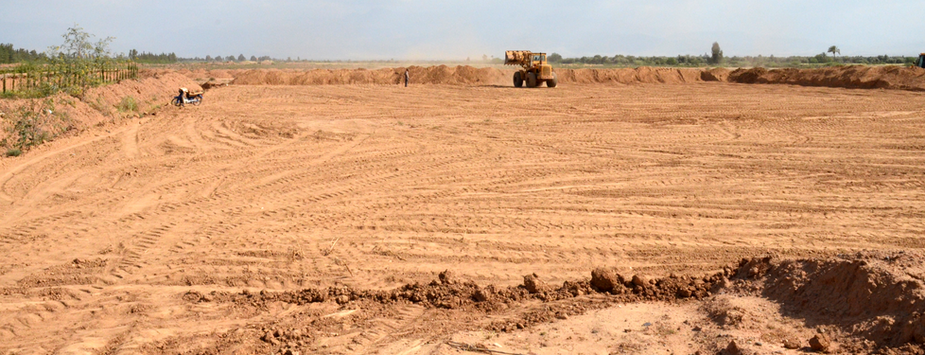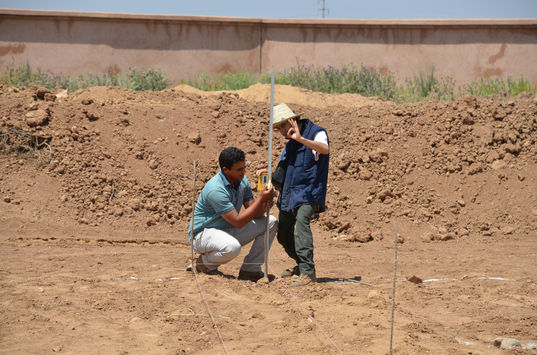
LUMBRICULTURAL FARM IN ARID ZONE
Recycling of organic materials by earthworms
Launch of the first vermicultural farm in Morocco for the production of vermicompost and the recycling of organic materials (horse manure) in the city of Marrakech.
A technical challenge in a region where it is between 35 ° C and 49 ° C during the three summer months. This project was made possible by adapting techniques: lowered bed to keep the ground cool, installation of heat screens to block the heat and foggers.
At the end of the 2nd year, the farm was producing more than 80 tonnes of top quality vermicompost by recycling around 500 m³ of manure annually.
My mission over 3 years:
Overall design of the project.
Implementation (earthworks, site layout).
Launch of operations.
Formation of a technical team.

The project: Installation of a worm farm in an arid zone

Anti-flooding system:
Installation of water drainage ditches and protective dikes. Operating area 3000m², recycling capacity 500m³, annual production of vermicompost around 80 tonnes / year.
Planting of a double-curtain hedge of pioneer species in order to protect the site while producing seeds from companion trees.
Installation of a system of drains to collect and evacuate water in the heart of the farm.
Cultivation area: 3 greenhouses "delta 9" 54m long with leachate recovery system.
Pre-composting space and leachate treatment with phyto-purification through bamboo production.
Compost drying, sieving and bagging space .
General informations
Site: 6500 m²
Access to borehole water at 110m, slightly salty.
Wind protection: Double curtain fence.
Flood protection: -1m drainage ditch and 2m high dike planted on both sides, reinforced by 150m of drains around the cultivation beds.
3 greenhouses "delta 9" 54m long.
2 areas for precomposting raw materials.
1 greenhouse drying, sieving and bagging.
Establishment of a horse manure recovery network in the Marrakech area.

The project in pictures
DESIGN
Design and evolution of the project over 7 years
Design is the feasibility study of a project taking into account the resources of the place, your time, your budget and your objectives.
The realization is done in stages according to the means implemented and the possible seasons for the installation.
The design consists of plans, schedules, budgets, allowing to define the stages of implementation.
Setting up production greenhouses according to the accessibility of raw materials and securing supply and prices over several years.
Job creation, training of skilled workers who will be supported up to the management of the entire production chain.
Accompaniement up to full autonomy.
EARTHWORKS
Prepare the site for the farm
The machines, admittedly not ecologically viable, nevertheless make it possible to speed up the realization of medium and large-sized projects.
Installation of anti-erosion dikes, water flow ditches around production units.
The right choice of machines, tools, teams, is essential for the implementation of the first step.
Anticipate at best the functional and climatic issues of the project. Traffic of heavy vehicles over 10 tonnes, floods, drought and temperatures up to 50 ° C, with probability of storms ...
LOCATION OF PRODUCTION UNITS
Planning your project
Installation of three types of greenhouses:
Greenhouse 1: 2 beds of 54m lowered by 50cm.
Greenhouse 2: 2 beds of 54m at ground level with a slight slope (0.2%)
Greenhouse 3: 250m² screed with 2 inclined slopes for leachate recovery (0.2% slope).
HEDGES
Protective hedges
Double curtain of hedges over 300m linear or 600m of windbreak hedges.
Planting large trees in the middle of greenhouses for shade.
The first hedge is drought tolerant pioneer trees with thorns to protect the site from roaming animals and malicious people.
DRAINS, FLOOD MANAGEMENT
Rainwater drainage
Installation of drains to protect the earthworms, to keep the spaces passable during and after the rain.
Dimension of ditches: 50 cm wide by 40 cm deep, slope of 0.3%.
150 linear meters of drains installed.
IRRIGATION
Moisture management in culture beds
Installation of sprinklers at a height of 2m.
LEACHATE RECOVERY
Manage leachate
Installation of leachate recovery systems from cultivation beds.
WORM CULTIVATION, BED INOCULATION
Start the cultivation of worms
Inoculation of earthworms on beds prepared with pre-composted materials.
Management of irrigation against drought.
Counting earthworm populations, reproduction periods, stages of decomposition, earthworm migration, harvesting of raw material .
PRE-COMPOSTING OF RAW MATERIALS
Preparing food for the worms
The pre-composting area allows raw materials to rise in temperature to prevent the escape of worms and thus accelerate the process of transformation into compost.
- Installation of a phyto-purification with the means on board to manage the leachate from the fresh manure.
Anticipate the passage of trucks and the weight of loads at all times.
Adapt workspaces to tools and people.
EXTRACTION AND PACKAGING
Drying, sieving, bagging ...
Adapt drying zones.
Find the right tools (adapt them, make them) to sift the compost.
Bag, choose the right packaging.
Do you want to carry out this type of project?
Training is available:



.png)




































































































































































